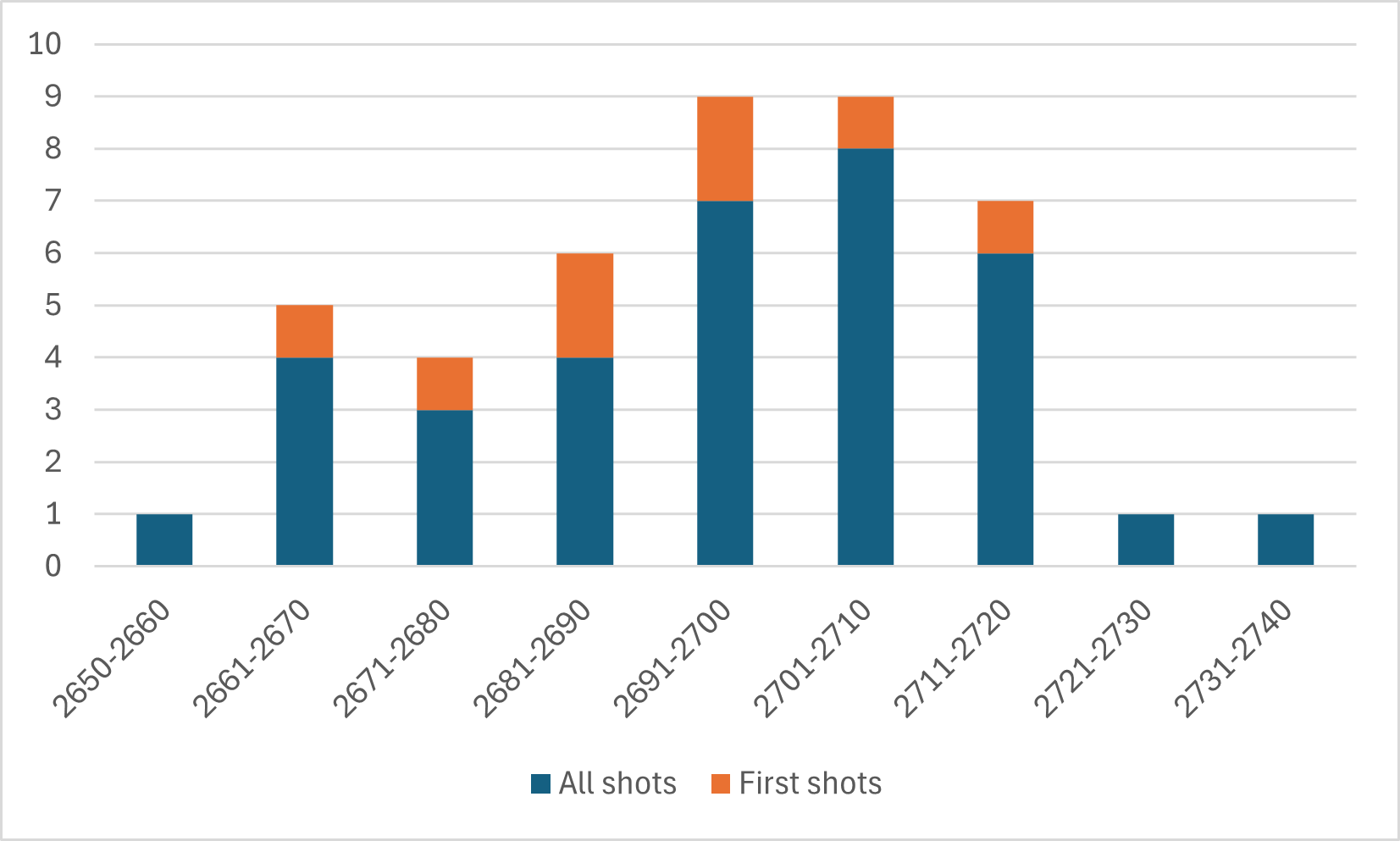I think it's useful to be clear on the hypothesis we are trying to test. To my interpretation it is "that the velocity of the first shot from a cold bore is meaningfully and consistently different from the mean velocity and spread". Note this is cold, not cold "clean", because I don't see any good reason to ever clean down to bare metal. A couple of patches occasionally is still "fouled".
If it isn't meaningfully and consistently different, any trend is immaterial, but it would be nice to know if it is - if that's actionable.
What would consistent and meaningful look like?
To allow us to take an action to control for any effect and realise a benefit, it would need to be consistent enough in a particular direction to avoid over-correcting in the other direction with any frequency, and consistent enough in magnitude to act on.
A meaningful difference in magnitude would by definition have to be "something outside the normal expected distribution of shot velocities", as that is the default solution - use the mean velocity and form expectations for hit probability based on standard deviation (although this is only very infrequently the most significant factor).
We shouldn't have an inherent position on what the answer is, but we should be trying to use available data to test this question and find the right answer. Practically speaking, to confidently identify that something is different from the rest of the population requires a lot of data, and it takes a lot less data to identify that there isn't a meaningful difference.
My initial scan of data available to me suggests there is not a difference, but I would like to know if that's not the case. I might miss less things.
So what data do I have to test this? A scan across multiple rifles and loads (5x .223s, a 6mm223, a 6.5G, a 6.5CM, a .260, and a .308) indicates that the majority of the first shots fall within the normal distribution for that rifle.
You would expect, particularly on shorter shot strings, that sometimes the first shot will be the lowest velocity. In a 3 shot group you have a 1 in 3 probability of that. A larger dataset will provide a better picture of your overall velocity distribution. You would also expect that the 2nd velocity will be higher than the first, around 50% of the time. The other 50% or so, it will be lower. Sometimes, depending on how consistent your velocities are, it will be the same. This is sort of immaterial unless the trend is extremely consistent in one direction and allows us to take some sort of corrective action, and of a sufficient magnitude that we'd realise a benefit from taking that action. Looking at that trend isn't terribly useful. Across 15 shot strings I looked at, 5 of the first shots were a higher velocity than the next, and 10 were lower - however that isn't really sufficiently different from 50/50 to make any statement - what we can say is that with different rifles and loads the direction isn't consistent enough to be actionable even if it was real.
What about with one rifle and one load? I have 39 shots of chrono data across 8 strings (some 1 shot) with the same rifle and load with a cold bore.
This is what the distribution of these shots, and the first shots from each string, looks like.
The velocity distribution is tending towards a normal distribution. The mean is 2695 with an SD of 19. There isn't sufficient data to form a better picture. You might infer that there is some skewness in velocities generally below the mean, and the first shot distribution isn't showing any tendency to be different to the overall shot distribution. None of the first shots are outside the overall range, or would produce a different result than I would expect based on hit probability calculated with my velocity mean and standard deviation.
I'll add more data as I collect it but at this stage, I don't see any evidence for a meaningful trend across multiple rifles or this specific rifle and load.
This is insanely irrelevant to the average hunter - even if your first shot were consistently 50fps slower than your mean velocity, you might expect a 4cm difference in drop at 400 metres.
Welcome guest, is this your first visit? Create Account now to join.
Welcome to the NZ Hunting and Shooting Forums.
Search Forums
User Tag List
Results 1 to 15 of 42
Threaded View
-
06-08-2024, 10:44 AM #28
Similar Threads
-
Cold Bore First Shot
By McNotty in forum ShootingReplies: 42Last Post: 02-01-2024, 12:15 PM -
3 vs 5 shot groups
By Magnetite in forum Reloading and BallisticsReplies: 31Last Post: 23-04-2022, 03:12 PM -
Is it 'Cold Bore' or 'Foul Bore' ?
By redbang in forum ShootingReplies: 31Last Post: 17-01-2021, 08:42 PM -
3 Shot Cold Bore Group to 375yrds
By Lucky in forum ShootingReplies: 18Last Post: 24-09-2019, 03:16 PM -
cold/clean bore shot
By mawzer308 in forum ShootingReplies: 16Last Post: 05-02-2016, 08:31 PM
Tags for this Thread
Welcome to NZ Hunting and Shooting Forums! We see you're new here, or arn't logged in. Create an account, and Login for full access including our FREE BUY and SELL section Register NOW!!




 58Likes
58Likes LinkBack URL
LinkBack URL About LinkBacks
About LinkBacks





 Reply With Quote
Reply With Quote


Bookmarks